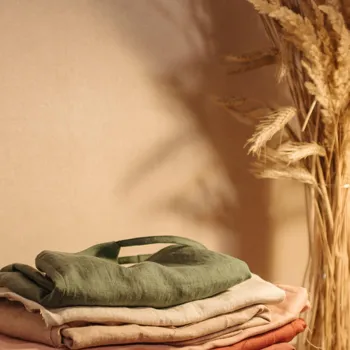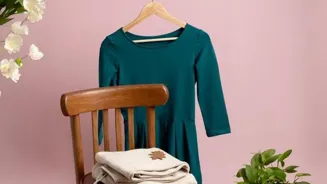Discover how to shop ethically and stylishly in the world of fashion sustainability. Make a positive impact with conscious choices
The world of fashion, dazzling as it is, often comes with a hidden cost.
Fast fashion, with its trendy and affordable clothes, has contributed significantly to environmental issues like pollution, resource depletion, and unethical labour practices. But fret not, fashion enthusiasts!

You can still stay stylish and trendy while making conscious choices that positively impact the planet and its people. Sustainable fashion is no longer a niche movement; it's a growing wave that empowers shoppers to make informed decisions and embrace a more responsible approach to clothing.
This article will guide you on how to navigate the world of sustainable fashion, offering tips and insights to shop ethically and stylishly, all while reducing your environmental footprint.
Understanding impact of fast fashion for sustainable choices
The first step towards sustainable fashion is understanding the impact of your choices. Fast fashion thrives on quickly produced, low-quality garments, often made in factories with poor working conditions and harmful environmental practices.

These clothes are designed to be worn only a few times before being discarded, leading to massive textile waste. By becoming aware of these issues, you can start questioning your shopping habits and start looking for brands and retailers that prioritize ethical and environmental responsibility.
Start by researching the brands you currently purchase from. Look for information about their manufacturing processes, labour practices, and commitment to reducing their environmental impact. A little research can go a long way in ensuring your money supports businesses aligned with your values.
You can reduce your textile use, and make a sustainable impact into fashion.
Reduce environmental impact by embracing pre-loved clothing through thrifting and swaps
One of the most effective ways to reduce your environmental impact is to embrace pre-loved clothing. Shopping at thrift stores, vintage shops, and online resale platforms gives clothes a second life, diverting them from landfills.

Not only is thrifting an eco-friendly option, but it also allows you to discover unique and stylish pieces that you won't find in mainstream stores. Plus, it's often much more affordable than buying new clothes.
Consider hosting clothing swaps with friends or family to exchange items you no longer wear. This is a fun and sustainable way to refresh your wardrobe without contributing to the demand for new clothing production. You can try styling the clothes with something new too make it look unique.
Choose sustainable fabrics like organic cotton, linen, hemp, and recycled materials to reduce environmental impact
Material matters, and choosing clothes made from sustainable fabrics can make a big difference. Organic cotton, linen, hemp, and recycled materials are all excellent choices. Organic cotton is grown without harmful pesticides and fertilizers, reducing its environmental impact.
Linen, derived from the flax plant, is a durable and breathable fabric that requires less water and pesticides than cotton. Hemp is another sustainable option, known for its strength and rapid growth.
Recycled materials, such as recycled polyester made from plastic bottles, give waste a new purpose. When shopping, look for certifications like GOTS (Global Organic Textile Standard) and Oeko-Tex, which ensure that the fabric meets certain environmental and social standards.
By choosing brands that prioritize sustainable fabrics, you can support responsible production practices and reduce your environmental footprint.
Shop mindfully, invest in quality, care for clothes, reduce waste
Before making a purchase, ask yourself if you truly need the item. Avoid impulse buying and focus on building a wardrobe of versatile pieces that you can mix and match. Choose classic styles over fleeting trends to ensure your clothes remain stylish for years to come.

When you do need to buy something new, invest in high-quality pieces that are made to last. While they may cost more upfront, durable clothes will save you money in the long run and reduce the need for frequent replacements.
Take care of your clothes by washing them properly, repairing minor damages, and storing them correctly. Proper care extends the life of your garments and reduces the environmental impact associated with producing new ones.
By adopting a mindful approach to fashion, you can curate a wardrobe that reflects your personal style while minimizing your environmental impact.
Support ethical, sustainable brands for positive fashion industry change
Supporting ethical and sustainable brands is crucial for driving change in the fashion industry. Look for brands that prioritize fair labour practices, transparency, and environmental responsibility.

Many sustainable brands are committed to paying fair wages, providing safe working conditions, and reducing their carbon footprint. Research brands before making a purchase to ensure they align with your values.
Look for certifications like Fair Trade, which indicates that the product meets certain ethical standards. Check the brand's website for information about their manufacturing processes, sourcing practices, and environmental initiatives.
By supporting ethical and sustainable brands, you can encourage more companies to adopt responsible practices and create a more sustainable fashion industry.
Sustainable fashion promotes eco-friendly choices in style
Fashion is a form of self-expression, and it doesn't have to come at the planet's expense. Sustainable fashion is all about making informed choices, embracing creativity, and celebrating individuality.
By adopting the strategies outlined in this article, you can shop ethically and stylishly, reducing your environmental footprint and supporting a more responsible fashion industry. Remember, every small step counts, and together, we can create a fashion future that is both stylish and sustainable.
AI Generated Content. Glance/InMobi shall have no liability for the content









